Global and China Hybrid Electric Vehicle (HEV) Research Report, 2023-2024
1. In 2025, the share of plug-in/extended-range hybrid electric passenger cars by sales in China is expected to rise to 40%.
In 2023, China sold 2.754 million plug-in/extended-range hybrid electric passenger cars, a year-on-year spurt of 85.5%, a growth rate higher than battery electric passenger car models for five consecutive quarters, and the overall growth of the new energy vehicle market.

In China, plug-in/extended-range hybrid electric passenger cars already make up 30.6% of new energy passenger cars. In 2023, automakers in China launched more than 30 new plug-in/extended-range hybrid electric vehicle models. As new models continue to emerge, the sales of plug-in/extended-range hybrid electric passenger cars will be on the rise. It is expected that by 2025, plug-in/extended-range hybrid electric passenger cars will take up 40% of the new energy passenger car sales in China.
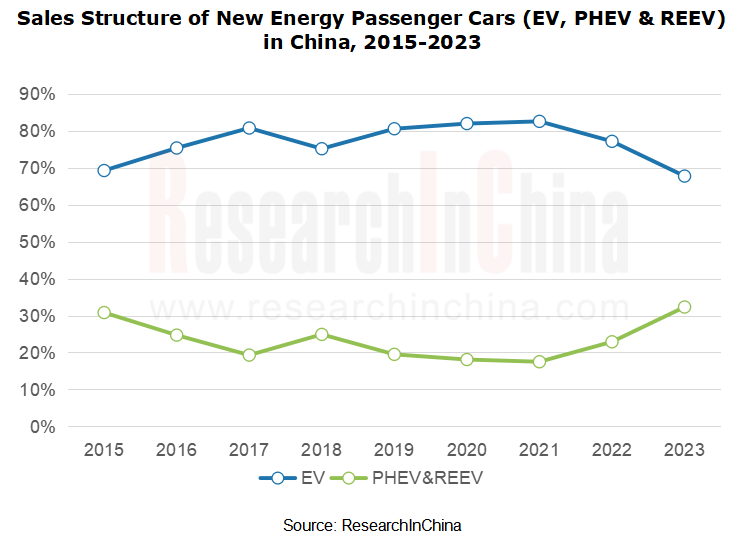
2. “Electrification plans” are set back globally, and hybrid technology ushers in a boom period.
As battery electric vehicles (BEV) see a lower-than-expected growth in sales, major global automakers concentrate more on hybrid electric vehicle (HEV) models to meet customers’ demand and the need for a gradual transition to electrification. By combining conventional internal combustion engine (ICE) system with electric systems, HEV models can help to reduce fuel consumption and emissions in the short term. Also they are very superior in adapting to consumers’ driving habits and alleviating range anxiety.
From the transformation into electrification by global OEMs, it can be seen that GM, Ford and Audi have all postponed their electrification plans. Volkswagen has scaled down its BEV production in Europe. The reasons for the delays and adjustments are reduced orders and lower-than-expected sales. HEV models, especially PHEV & REEV, have become a compromise of automakers in transformation into electrification. It is expected that the launch of new BEVs will slow down in 2024, and PHEV & REEV models will be rolled out in quantities.
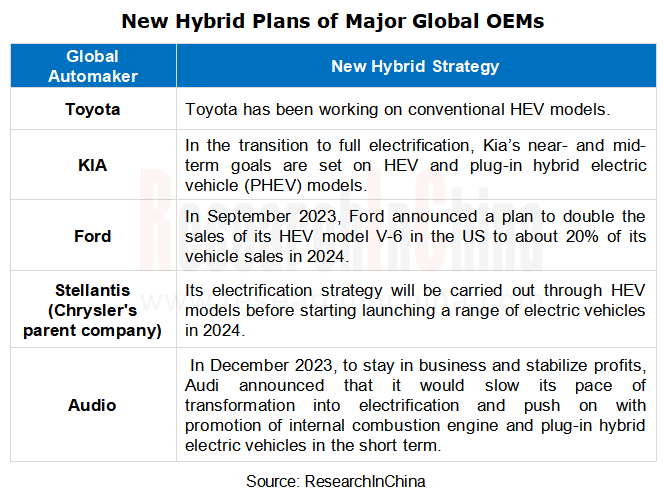
3. The boom of hybrid electric passenger cars gives a big boost to the downstream components market.
3.1 Multi-motor/electronically controlled hybrid power systems become mainstream, favoring the rapid development of the industry chain.
In hybrid power systems, dual-motor hybrid power systems have great advantages in fuel consumption, especially paired with long-range batteries. BYD, Li Auto, Geely and Great Wall among others therefore have launched their own hybrid power systems and quickly seized the market with plug-in hybrid or extended-range energy types.
The ratio between hybrid vehicle and motors is generally 1:2/1:3. When HEVs replace ICE vehicles and rapidly increase in volume, they will be a great driving force in the development of the motor industry chain. In the case of the P1+P3 hybrid configuration, P1 is the input shaft with a motor (generator), and P3 is the output shaft with a motor (drive motor). The P1+P3 configuration actually means installation of two motors. To achieve the four-wheel drive performance, HEV models add a motor to the position of P4. This is the P1+P3+P4 configuration, namely, three motors.
Dual-electronic control systems include two sets of modules that simultaneously control the generator and drive motor to implement the strategies for the entire hybrid power system. As Chinese independent automakers launch more projects, ever more electronic control suppliers participate in the competition in the dual-electronic control system market. Sungrow E-Power, BorgWarner and other suppliers have forged long-term partnerships with automakers like Geely and Great Wall on dedicated hybrid transmission (DHT) vehicles. The dual-electronic control system market thus keeps growing accordingly.
In Changan's P1+P3 hybrid architecture, the drive system uses TC387, a quad-core chip with computing power of 300 megabits per core, for high-precision dynamic torque response control and real-time active noise reduction. It adopts dual 4-core high-compute electronic control chips, and the core is the optimal A-ECMS intelligent energy consumption algorithm for high-precision control and real-time monitoring.
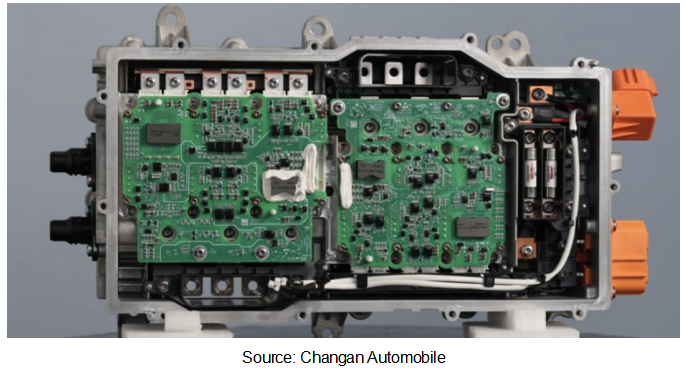
At the 2023 Munich Motor Show (IAA MOBILITY) in Germany, Sungrow E-Power introduced a hybrid dual-motor controller along with Lynk & Co EM-P, a super extended-range electric solution that uses Sungrow’s HEM hybrid dual-motor controller and applies the new-generation power device parallel technology.
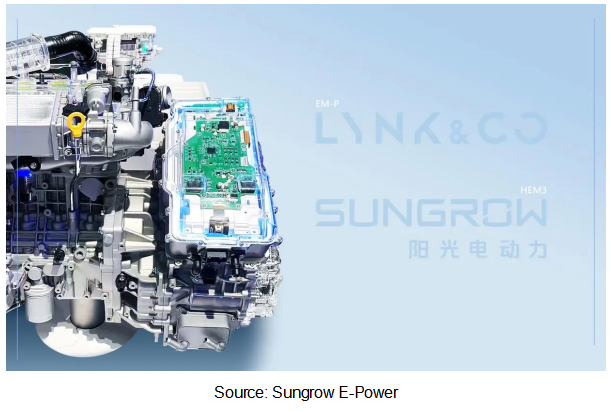
3.2 Dedicated hybrid engines (DHE) with thermal efficiency of 45% have been mass-produced, and industrial upgrade is imminent.
The thermal efficiency of engines is closely related to the fuel consumption and cruising range of HEVs. The higher the engine thermal efficiency, the lower the carbon emissions and user fuel consumption in the same power output. DHEs use deep electromechanical coupling to change the operating conditions from the surface to the domain or line, favoring ultra-high fuel efficiency.
As OEMs like Geely, Dongfeng, BYD, GAC, Great Wall, and Chery lavish on research and development, hybrid electric passenger car models with thermal efficiency higher than 43% have been mass-produced by the end of 2023, especially the 2024 Voyah Dreamer carrying the new Lanhai Power hybrid engine (a 1.5T engine with front and rear dual motors) with thermal efficiency up to 45.18%. It is expected that in 2025, DHEs with thermal efficiency of 45% will find massive industrial application.
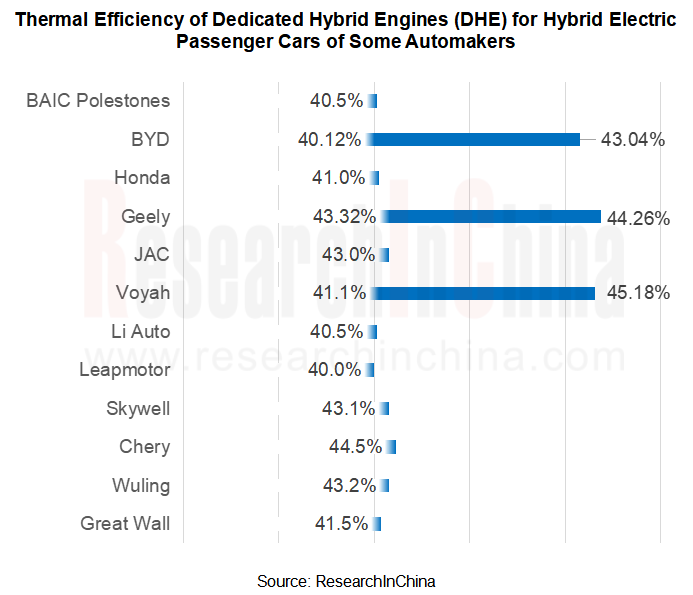
Autonomous Driving Domain Controller and Central Computing Unit (CCU) Industry Report, 2025
Research on Autonomous Driving Domain Controllers: Monthly Penetration Rate Exceeded 30% for the First Time, and 700T+ Ultrahigh-compute Domain Controller Products Are Rapidly Installed in Vehicles
L...
China Automotive Lighting and Ambient Lighting System Research Report, 2025
Automotive Lighting System Research: In 2025H1, Autonomous Driving System (ADS) Marker Lamps Saw an 11-Fold Year-on-Year Growth and the Installation Rate of Automotive LED Lighting Approached 90...
Ecological Domain and Automotive Hardware Expansion Research Report, 2025
ResearchInChina has released the Ecological Domain and Automotive Hardware Expansion Research Report, 2025, which delves into the application of various automotive extended hardware, supplier ecologic...
Automotive Seating Innovation Technology Trend Research Report, 2025
Automotive Seating Research: With Popularization of Comfort Functions, How to Properly "Stack Functions" for Seating?
This report studies the status quo of seating technologies and functions in aspe...
Research Report on Chinese Suppliers’ Overseas Layout of Intelligent Driving, 2025
Research on Overseas Layout of Intelligent Driving: There Are Multiple Challenges in Overseas Layout, and Light-Asset Cooperation with Foreign Suppliers Emerges as the Optimal Solution at Present
20...
High-Voltage Power Supply in New Energy Vehicle (BMS, BDU, Relay, Integrated Battery Box) Research Report, 2025
The high-voltage power supply system is a core component of new energy vehicles. The battery pack serves as the central energy source, with the capacity of power battery affecting the vehicle's range,...
Automotive Radio Frequency System-on-Chip (RF SoC) and Module Research Report, 2025
Automotive RF SoC Research: The Pace of Introducing "Nerve Endings" such as UWB, NTN Satellite Communication, NearLink, and WIFI into Intelligent Vehicles Quickens
RF SoC (Radio Frequency Syst...
Automotive Power Management ICs and Signal Chain Chips Industry Research Report, 2025
Analog chips are used to process continuous analog signals from the natural world, such as light, sound, electricity/magnetism, position/speed/acceleration, and temperature. They are mainly composed o...
Global and China Electronic Rearview Mirror Industry Report, 2025
Based on the installation location, electronic rearview mirrors can be divided into electronic interior rearview mirrors (i.e., streaming media rearview mirrors) and electronic exterior rearview mirro...
Intelligent Cockpit Tier 1 Supplier Research Report, 2025 (Chinese Companies)
Intelligent Cockpit Tier1 Suppliers Research: Emerging AI Cockpit Products Fuel Layout of Full-Scenario Cockpit Ecosystem
This report mainly analyzes the current layout, innovative products, and deve...
Next-generation Central and Zonal Communication Network Topology and Chip Industry Research Report, 2025
The automotive E/E architecture is evolving towards a "central computing + zonal control" architecture, where the central computing platform is responsible for high-computing-power tasks, and zonal co...
Vehicle-road-cloud Integration and C-V2X Industry Research Report, 2025
Vehicle-side C-V2X Application Scenarios: Transition from R16 to R17, Providing a Communication Base for High-level Autonomous Driving, with the C-V2X On-board Explosion Period Approaching
In 2024, t...
Intelligent Cockpit Patent Analysis Report, 2025
Patent Trend: Three Major Directions of Intelligent Cockpits in 2025
This report explores the development trends of cutting-edge intelligent cockpits from the perspective of patents. The research sco...
Smart Car Information Security (Cybersecurity and Data Security) Research Report, 2025
Research on Automotive Information Security: AI Fusion Intelligent Protection and Ecological Collaboration Ensure Cybersecurity and Data Security
At present, what are the security risks faced by inte...
New Energy Vehicle 800-1000V High-Voltage Architecture and Supply Chain Research Report, 2025
Research on 800-1000V Architecture: to be installed in over 7 million vehicles in 2030, marking the arrival of the era of full-domain high voltage and megawatt supercharging.
In 2025, the 800-1000V h...
Foreign Tier 1 ADAS Suppliers Industry Research Report 2025
Research on Overseas Tier 1 ADAS Suppliers: Three Paths for Foreign Enterprises to Transfer to NOA
Foreign Tier 1 ADAS suppliers are obviously lagging behind in the field of NOA.
In 2024, Aptiv (2.6...
VLA Large Model Applications in Automotive and Robotics Research Report, 2025
ResearchInChina releases "VLA Large Model Applications in Automotive and Robotics Research Report, 2025": The report summarizes and analyzes the technical origin, development stages, application cases...
OEMs’ Next-generation In-vehicle Infotainment (IVI) System Trends Report, 2025
ResearchInChina releases the "OEMs’ Next-generation In-vehicle Infotainment (IVI) System Trends Report, 2025", which sorts out iterative development context of mainstream automakers in terms of infota...